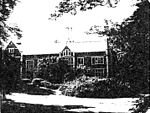Walnut Hills Cemetery (Brookline, Massachusetts)
1875 establishments in MassachusettsBuildings and structures in Brookline, MassachusettsCemeteries established in the 1870sCemeteries in Norfolk County, MassachusettsCemeteries on the National Register of Historic Places in Massachusetts ... and 2 more
National Register of Historic Places in Brookline, MassachusettsRural cemeteries

Walnut Hills Cemetery is a historic cemetery on Grove Street and Allandale Road in Brookline, Massachusetts. It encompasses 45.26 acres (18.32 ha), with mature trees and puddingstone outcrops, and was laid out in 1875 in the then-fashionable rural cemetery style. Many past prominent citizens of the town, including architect H. H. Richardson, are buried here. The cemetery was listed on the National Register of Historic Places in 1985.
Excerpt from the Wikipedia article Walnut Hills Cemetery (Brookline, Massachusetts) (License: CC BY-SA 3.0, Authors, Images).Walnut Hills Cemetery (Brookline, Massachusetts)
Baker Circle,
Geographical coordinates (GPS) Address External links Nearby Places Show on map
Geographical coordinates (GPS)
| Latitude | Longitude |
|---|---|
| N 42.302777777778 ° | E -71.147222222222 ° |
Address
Walnut Hills Cemetery
Baker Circle
02467
Massachusetts, United States
Open on Google Maps








